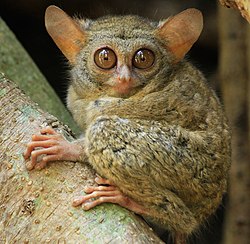| Gursky's spectral tarsier | |
|---|---|
 | |
| At Sulawesi, Indonesia | |
| Scientific classification | |
| Kingdom: | Animalia |
| Phylum: | Chordata |
| Class: | Mammalia |
| Order: | Primates |
| Suborder: | Haplorhini |
| Family: | Tarsiidae |
| Genus: | Tarsius |
| Species: | T. spectrumgurskyae |
| Binomial name | |
| Tarsius spectrumgurskyae Shekelle, Groves, Maryanto & Mittermeier, 2017 | |
Gursky's spectral tarsier (Tarsius spectrumgurskyae), also known locally as wusing, [2] [3] is a species of tarsier found in the island of Sulawesi in Indonesia. A recent taxonomic revision split this species off from the spectral tarsier and other tarsier species based on difference in vocalisations and pelage. [2] [3] These tarsiers, like other species of primates, are able to communicate with other individuals of the same species through flexible call patterns, in which they output different note patterns based on their duet partner's calls. [4]
